各国民族服装英文介绍知识讲解
- 格式:ppt
- 大小:5.32 MB
- 文档页数:25
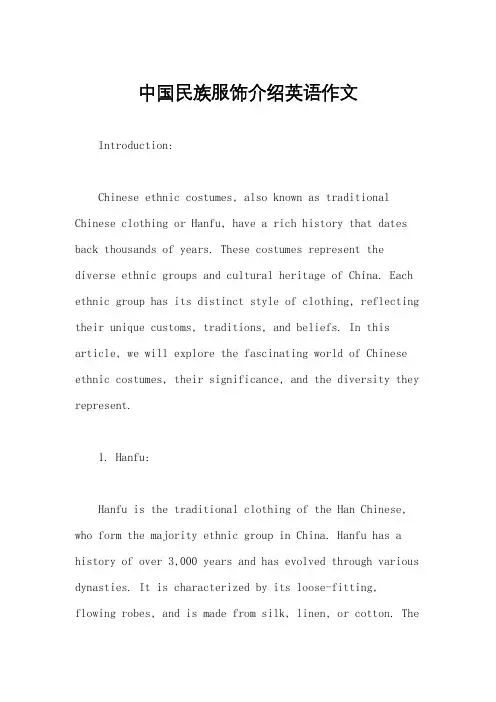
中国民族服饰介绍英语作文Introduction:Chinese ethnic costumes, also known as traditional Chinese clothing or Hanfu, have a rich history that dates back thousands of years. These costumes represent the diverse ethnic groups and cultural heritage of China. Each ethnic group has its distinct style of clothing, reflecting their unique customs, traditions, and beliefs. In this article, we will explore the fascinating world of Chinese ethnic costumes, their significance, and the diversity they represent.1. Hanfu:Hanfu is the traditional clothing of the Han Chinese, who form the majority ethnic group in China. Hanfu has a history of over 3,000 years and has evolved through various dynasties. It is characterized by its loose-fitting, flowing robes, and is made from silk, linen, or cotton. Thestyle and design of Hanfu vary depending on the gender, social status, and occasion.For men, Hanfu typically consists of a robe, a long skirt, and a sash. The robe is often adorned with intricate embroidery and exquisite patterns. Women's Hanfu, on the other hand, includes a long, flowing dress called a Ruqun, which consists of an upper garment and a skirt. The Ruqun can be further embellished with accessories such as a waistband, a shawl, and a headdress.Hanfu represents the elegance, grace, and modesty of ancient Chinese culture. It is often worn duringtraditional festivals, weddings, and other formal occasions to showcase the wearer's respect for tradition and their cultural identity.2. Tibetan Costume:Tibetan costumes are unique and distinct, reflecting the rich cultural heritage of the Tibetan people. The traditional Tibetan costume for men is called a "Chuba." Itis a loose, long-sleeved robe made of wool or silk. The Chuba is often adorned with colorful patterns and intricate designs. Men also wear a waistband and a hat called a "Tsepa" to complete their traditional attire.Women's traditional Tibetan costume is called a "Chuba" as well, but it is more elaborate and vibrant compared to men's. It consists of a long, flowing dress with a widebelt around the waist. The dress is often made of silk and is adorned with intricate embroidery, vibrant colors, and traditional Tibetan motifs. Women also wear various accessories like jewelry, headdresses, and aprons to enhance their traditional look.Tibetan costumes are not only worn on special occasions but are also a part of daily life. They represent the Tibetan people's strong connection to their culture, religion, and natural surroundings.3. Uygur Costume:Uygur costumes are an integral part of the Uygur ethnicgroup's cultural identity in China. The Uygur people, who primarily reside in the Xinjiang Uygur Autonomous Region, have a unique and diverse clothing style influenced bytheir nomadic heritage and Islamic traditions.Uygur men traditionally wear long, loose-fitting robes made of silk or cotton. The robe is often paired with loose trousers and a hat. The colors and patterns of their clothing represent their cultural and religious beliefs. Uygur women wear vibrant, long-sleeved dresses called "Atlas" or "Kemis." These dresses are made of silk and are adorned with intricate embroidery and vibrant patterns. Women also wear a headdress, usually made of silk, which is decorated with beads, feathers, and other ornaments.Uygur costumes are not only visually appealing but also reflect the Uygur people's history, lifestyle, andreligious practices. They are often worn during festivals, weddings, and other celebrations to showcase their cultural pride and identity.4. Zhuang Costume:The Zhuang ethnic group, one of the largest minority groups in China, has its unique traditional costumes that reflect their rich cultural heritage. Zhuang costumes are known for their vibrant colors, intricate embroidery, and exquisite craftsmanship.Zhuang men traditionally wear a collarless jacket, loose trousers, and a headscarf. The jacket is often made of silk or cotton and is adorned with colorful embroidery. Women's traditional Zhuang costume, known as "Luozhuang," is even more elaborate. It consists of a jacket, a long skirt, and an apron. The jacket and skirt are often made of silk and are embellished with intricate embroidery, silver ornaments, and colorful ribbons.Zhuang costumes are not only worn on special occasions but are also a part of the Zhuang people's daily life. They represent their cultural pride, social status, and their connection to their ancestors and nature.Conclusion:Chinese ethnic costumes, with their diverse styles, designs, and cultural significance, are a testament to the rich heritage and diversity of China's ethnic groups. Each costume represents a unique blend of history, tradition, and cultural identity. Whether it's the elegant Hanfu, the vibrant Tibetan costume, the Islamic-influenced Uygur costume, or the intricate Zhuang costume, these traditional attires showcase the beauty and cultural pride of the Chinese people. Preserving and promoting these costumes is crucial in maintaining the cultural diversity and heritage of China.。
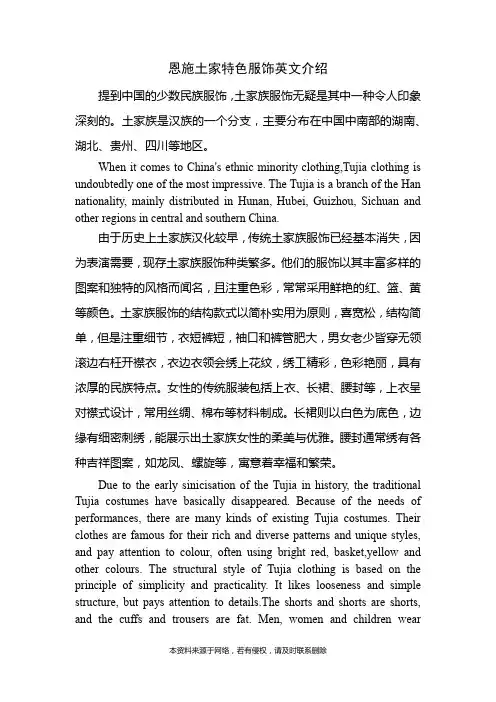
恩施土家特色服饰英文介绍提到中国的少数民族服饰,土家族服饰无疑是其中一种令人印象深刻的。
土家族是汉族的一个分支,主要分布在中国中南部的湖南、湖北、贵州、四川等地区。
When it comes to China's ethnic minority clothing,Tujia clothing is undoubtedly one of the most impressive. The Tujia is a branch of the Han nationality, mainly distributed in Hunan, Hubei, Guizhou, Sichuan and other regions in central and southern China.由于历史上土家族汉化较早,传统土家族服饰已经基本消失,因为表演需要,现存土家族服饰种类繁多。
他们的服饰以其丰富多样的图案和独特的风格而闻名,且注重色彩,常常采用鲜艳的红、篮、黄等颜色。
土家族服饰的结构款式以简朴实用为原则,喜宽松,结构简单,但是注重细节,衣短裤短,袖口和裤管肥大,男女老少皆穿无领滚边右枉开襟衣,衣边衣领会绣上花纹,绣工精彩,色彩艳丽,具有浓厚的民族特点。
女性的传统服装包括上衣、长裙、腰封等,上衣呈对襟式设计,常用丝绸、棉布等材料制成。
长裙则以白色为底色,边缘有细密刺绣,能展示出土家族女性的柔美与优雅。
腰封通常绣有各种吉祥图案,如龙凤、螺旋等,寓意着幸福和繁荣。
Due to the early sinicisation of the Tujia in history, the traditional Tujia costumes have basically disappeared. Because of the needs of performances, there are many kinds of existing Tujia costumes. Their clothes are famous for their rich and diverse patterns and unique styles, and pay attention to colour, often using bright red, basket,yellow and other colours. The structural style of Tujia clothing is based on the principle of simplicity and practicality. It likes looseness and simple structure, but pays attention to details.The shorts and shorts are shorts, and the cuffs and trousers are fat. Men, women and children wearcollarless right collarless skirts. The edges and collars will be embroidered with patterns. The embroidery is wonderful, the colour is gorgeous, and it has strong national characteristics. Women's traditional clothing includes tops, long skirts, waist covers, etc.The tops are designed in pairs, which are commonly made of silk, cotton and other materials. The long skirt is based on white, with fine embroidery on the edges, which can show the softness and elegance of Tujia women. The waist seal is usually embroidered with various auspicious patterns, such as dragons and phoenixes, spirals, etc., which means happiness and prosperity.不同的服饰,是区分不同民族的一个重要标志,随着时代的发展和社会的进步,土家族服饰虽历经变革,但任然保留了本民族传统的特点。
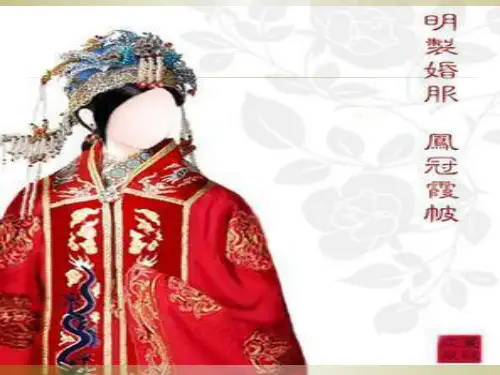
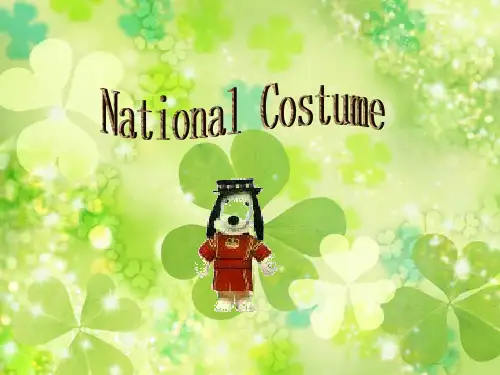
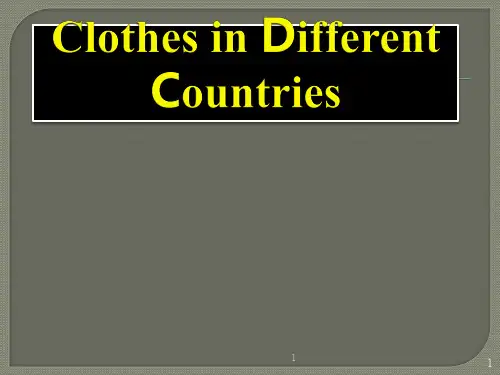
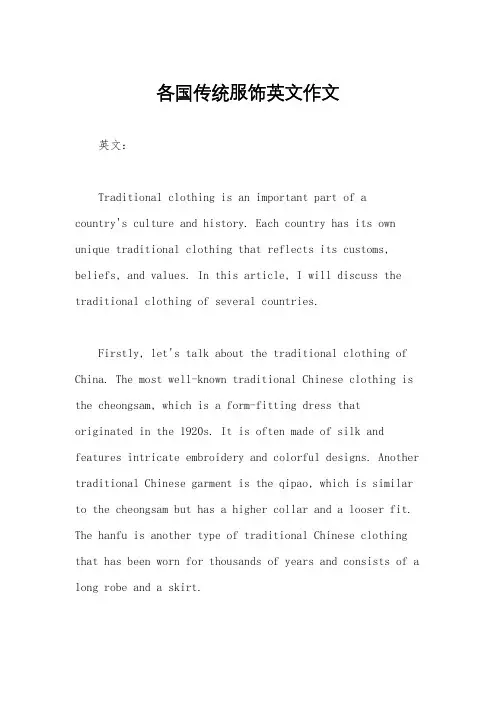
各国传统服饰英文作文英文:Traditional clothing is an important part of acountry's culture and history. Each country has its own unique traditional clothing that reflects its customs, beliefs, and values. In this article, I will discuss the traditional clothing of several countries.Firstly, let's talk about the traditional clothing of China. The most well-known traditional Chinese clothing is the cheongsam, which is a form-fitting dress thatoriginated in the 1920s. It is often made of silk and features intricate embroidery and colorful designs. Another traditional Chinese garment is the qipao, which is similar to the cheongsam but has a higher collar and a looser fit. The hanfu is another type of traditional Chinese clothing that has been worn for thousands of years and consists of a long robe and a skirt.Next, let's look at the traditional clothing of Japan. The kimono is the most iconic piece of traditional Japanese clothing. It is a long, flowing robe that is often made of silk and features elaborate designs and patterns. The yukata is a lighter and more casual version of the kimono that is worn in the summer. Another traditional Japanese garment is the hakama, which is a type of wide-legged pants that were originally worn by samurai.Moving on to India, the traditional clothing is incredibly diverse and varies depending on the region and occasion. The saree is perhaps the most well-known traditional Indian garment. It is a long piece of fabric that is draped around the body and can be worn in many different styles. The salwar kameez is another popular traditional Indian outfit that consists of a long tunic and loose pants. The dhoti is a type of garment that is worn by men and consists of a long piece of cloth that is wrapped around the waist.In Africa, traditional clothing also varies greatly depending on the region and culture. The dashiki is a typeof shirt that is commonly worn in West Africa. It is often made of bright, colorful fabric and features intricate patterns. The kaftan is another traditional African garment that is worn by both men and women. It is a long, loose-fitting robe that is often made of cotton or silk.In conclusion, traditional clothing is an importantpart of a country's culture and history. Each country hasits own unique traditional clothing that reflects its customs, beliefs, and values. By wearing traditional clothing, people can connect with their cultural heritage and celebrate their identity.中文:传统服饰是一个国家文化和历史的重要组成部分。
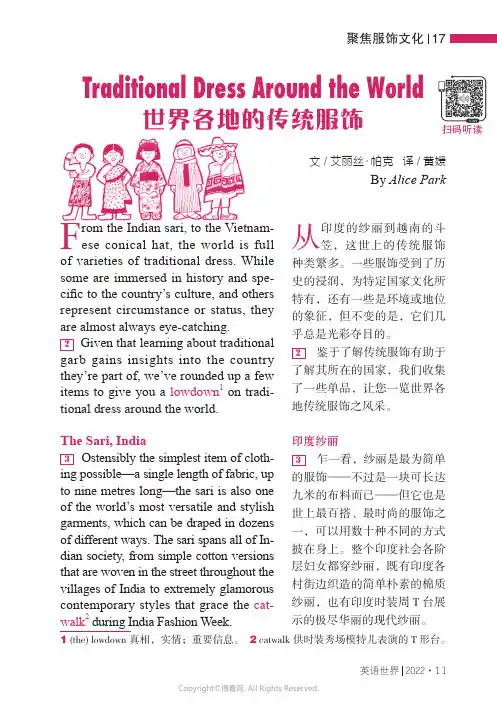


各国传统服装介绍英语作文In Japan, traditional clothing includes the kimono, which is a long, T-shaped robe with wide sleeves and a sash called an obi. The kimono is often worn for special occasions such as weddings, tea ceremonies, and festivals.In India, traditional clothing for women includes the sari, a long piece of fabric that is draped around the body and worn with a blouse. Men often wear the dhoti, a simple piece of cloth that is wrapped around the waist and legs.In Scotland, traditional clothing for men includes the kilt, a knee-length skirt that is made of tartan fabric and worn with a sporran (a pouch) and knee-high socks. Women often wear the tartan skirt and shawl, known as the "plaid."In China, traditional clothing includes the cheongsam for women, a form-fitting dress with a high collar and side slits, often made of silk. For men, the traditionalclothing is the changshan, a long tunic with a mandarin collar, often worn with loose-fitting trousers.In Nigeria, traditional clothing includes the agbadafor men, a flowing robe that is often embroidered and worn with a matching hat. Women often wear the iro and buba, a wrapper and blouse combination that is often brightly colored and patterned.In Russia, traditional clothing for women includes the sarafan, a sleeveless dress that is often worn over a blouse. Men often wear the kosovorotka, a traditional shirt with a collar that can be buttoned on the side.In Mexico, traditional clothing includes the huipil for women, a loose-fitting tunic often embroidered and worn with a skirt. Men often wear the charro suit, a formaloutfit that includes a jacket, vest, and trousers, often adorned with embroidery and silver buttons.。
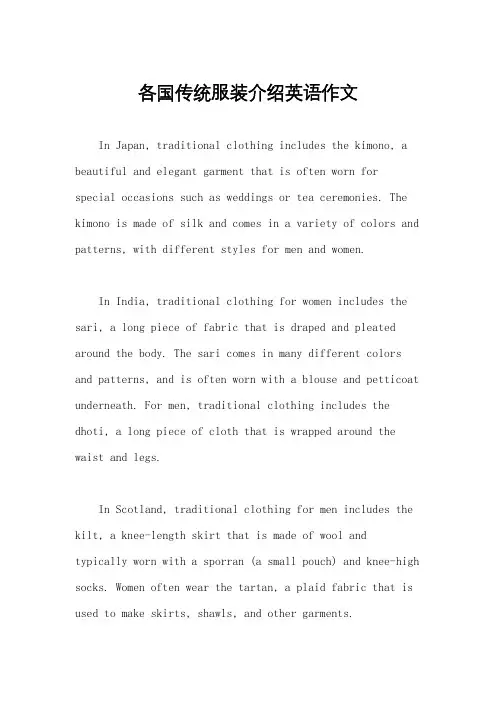
各国传统服装介绍英语作文In Japan, traditional clothing includes the kimono, a beautiful and elegant garment that is often worn for special occasions such as weddings or tea ceremonies. The kimono is made of silk and comes in a variety of colors and patterns, with different styles for men and women.In India, traditional clothing for women includes the sari, a long piece of fabric that is draped and pleated around the body. The sari comes in many different colors and patterns, and is often worn with a blouse and petticoat underneath. For men, traditional clothing includes the dhoti, a long piece of cloth that is wrapped around the waist and legs.In Scotland, traditional clothing for men includes the kilt, a knee-length skirt that is made of wool andtypically worn with a sporran (a small pouch) and knee-high socks. Women often wear the tartan, a plaid fabric that is used to make skirts, shawls, and other garments.In China, traditional clothing includes the qipao for women, a form-fitting dress with a high collar and slit skirt. For men, traditional clothing includes the changshan, a long tunic-style garment that is often worn for formal occasions.In Nigeria, traditional clothing includes the agbadafor men, a flowing robe that is often worn with a matching hat and embroidered shoes. Women often wear the iro and buba, a wrapper and blouse combination that comes in a variety of vibrant colors and patterns.In Sweden, traditional clothing includes the folkdräkt, a colorful and elaborate costume that is often worn for festivals and celebrations. The folkdräkt includes avariety of garments such as blouses, skirts, and aprons,all adorned with intricate embroidery and other decorations.In Mexico, traditional clothing for women includes the huipil, a loose-fitting tunic that is often embroidered and worn with a wrap-around skirt. Men often wear the guayabera,a lightweight shirt with four pockets and decorative pleats.In Saudi Arabia, traditional clothing for men includes the thobe, a long robe that is often worn with a headscarf called a ghutra. Women often wear the abaya, a long black cloak that covers the body and is worn with a headscarf called a hijab.。

各国传统服装介绍英语作文Traditional Clothing of Various Countries。
Traditional clothing is an important aspect of a country's culture and heritage. It reflects the history, climate, and lifestyle of the people. In this essay, wewill explore the traditional clothing of various countries.China is known for its colorful and intricatetraditional clothing. The most famous is the cheongsam, a close-fitting dress with a high collar and slit skirt. It was popularized in the 1920s and 1930s and is still wornfor formal occasions. The qipao is another traditional dress that is similar to the cheongsam but has a looser fit and is often made of silk. It is worn by women for special occasions such as weddings and festivals.Japan's traditional clothing is the kimono, a long robe with wide sleeves and a sash called an obi. It is made of silk or cotton and is worn by both men and women. Thepatterns and colors of the kimono vary depending on the occasion and the season. For example, a bright, colorful kimono is worn during festivals, while a subdued, understated one is worn for funerals.India is famous for its colorful and ornate traditional clothing. The sari is the most well-known garment, a long piece of cloth wrapped around the body and draped over the shoulder. It comes in a variety of fabrics and colors andis worn by women for formal occasions such as weddings and religious ceremonies. The salwar kameez is another traditional outfit, consisting of a long tunic and loose pants. It is worn by both men and women for everyday wear.Scotland's traditional clothing is the kilt, a knee-length skirt made of wool and worn by men. It is often worn with a sporran, a pouch worn around the waist, and a sgian dubh, a small knife worn in the sock. The tartan pattern of the kilt varies depending on the clan or region.Mexico's traditional clothing is the huipil, a loose-fitting tunic with colorful embroidery. It is worn by womenand comes in a variety of styles and patterns. The rebozo is another traditional garment, a long scarf worn over the head and draped over the shoulders. It is worn by both men and women and comes in a variety of colors and patterns.In conclusion, traditional clothing is an important part of a country's culture and heritage. It reflects the history, climate, and lifestyle of the people. From the cheongsam of China to the kilt of Scotland, each country has a unique and beautiful traditional garment.。
各国服饰英文介绍作文In Japan, traditional clothing is called "kimono". Itis typically made of silk and comes in a variety of colors and patterns. Kimonos are often worn for special occasions such as weddings or tea ceremonies.In India, women often wear a sari, which is a long piece of fabric that is draped around the body in various ways. Saris can be made of silk, cotton, or synthetic materials, and they come in a wide range of colors and patterns.In Scotland, the traditional clothing for men is the kilt, which is a knee-length skirt that is made of wool and typically worn with knee-high socks and a jacket. The pattern of the kilt, known as tartan, is often associated with specific clans or families.In Nigeria, women often wear a "gele", which is a headscarf that is tied in elaborate and stylish ways. Gelesare often worn for special occasions such as weddings or religious ceremonies, and they come in a variety of colors and patterns.In Saudi Arabia, men often wear a "thobe", which is a long robe that is typically white in color. It is worn as a symbol of modesty and is often paired with a headscarfcalled a "ghutra" or "shemagh".In South Korea, traditional clothing is called "hanbok". It is typically made of silk and consists of a wrap-around skirt and a jacket. Hanbok is often worn for special occasions such as weddings or festivals.In Mexico, traditional clothing for women includes the "huipil", which is a loose-fitting tunic that is often embroidered and comes in bright, vibrant colors. It is typically paired with a long, full skirt and a rebozo,which is a type of shawl.In Papua New Guinea, traditional clothing oftenconsists of grass skirts for women and loincloths for men.These garments are typically worn during cultural performances or ceremonies and are adorned with colorful decorations.。
纳西族服装英文介绍Naxi ethnic group服饰简介The Naxi ethnic group, with a history dating back thousands of years, is a prominent ethnic group in Yunnan Province, China. The traditional clothing of the Naxi ethnic group is a cultural and artistic treasure, embodying the unique culture and wisdom of the Naxi people.The Naxi women's clothing is particularly distinctive, with a rich variety of colors and patterns. The clothing is often made from high-quality cotton and features exquisite handicrafts. The style of the clothing changes with the region, such as the clothes worn by the Naxi women in the Lugu Lake area are shorter and feature more decorations, while the clothes worn in the Tacheng area are longer and more elegant.The Naxi men's clothing is relatively simple, generally wearing short black and white clothes and trousers. The clothes are often made of coarse cloth and feature geometric patterns.In recent years, with the development of tourism in China, more and more people have been to Yunnan Province, and many scenic spots in Yunnan have become popular tourist destinations. One such place is Lugu Lake, which is known as "the cradle of the Naxi people" because it is the birthplace of the Naxi people. In this area, many Naxi people still wear their traditional clothing every day, making their unique culture more visible to outsiders.The traditional clothing of the Naxi ethnic group not only represents the culture and history of the Naxi people but also embodies their attachment to their land and their way of life. It is a cultural heritage that should be protected and inherited.以下是该文本的翻译:纳西族服饰文化介绍纳西族是中国云南省一个有着悠久历史的著名民族。